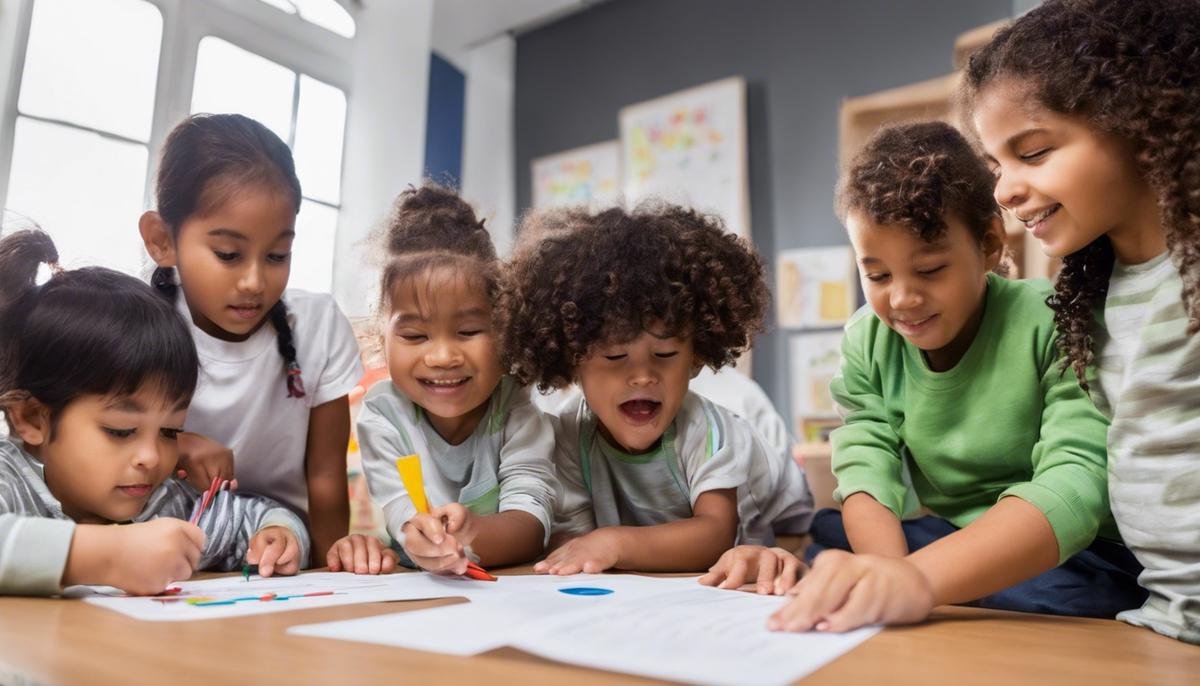
Autism, a complex neurodevelopmental disorder, is often identified by patterns of insistency in individuals, namely an unwavering adherence to specific routines or behaviours, also known as insistence on sameness. This unique trait, predominantly noticed in children with autism, is characterized by a deep-rooted resistance to change, with manifestations ranging from repetitive behaviours to emotional intensity when change is imposed. Acknowledging and comprehending this aspect of autism is crucial for parents and caregivers, often providing valuable insights into the child’s experiences and emotions. In this exploration, the lens is focused on the specific traits associated with insistence on sameness, the psychological motivations behind it, the thoughtful management of these behaviours and the cultivation of a healthy emotional environment.
Identifying Insistence on Sameness in Children with Autism
Title: Recognizing Signs of Insistence on Sameness in Children with Autism: A Parent’s Guide
Raising a child with autism is a journey filled with countless moments of joy, challenge, and discovery. Among the complexities and unique attributes that accompany autism is an often-observed trait: insistence on sameness. Quite simply, this refers to the inclination for repetitive behavior or actions. It’s a part of life for many children with autism and acknowledging it is a crucial stepping stone toward understanding and supporting these amazing children. This article aims to help parents navigate this often-bewildering aspect of autism, offering insights into recognizing insistence on sameness.
Insistence on sameness (IS), also known as a resistance to change or inflexible behavior, is essentially the preference for familiarity and routine. Children who show these tendencies prefer things to be in the same order, process, or environment every time. It might seem expansive and complicated to comprehend, but there are many everyday indicators one can look for to identify if a child with autism exhibits this trait.
The first sign to watch for is a strong attachment to routines. When children with autism develop a particular daily routine, they often get very upset when that routine is disrupted. This can manifest as a fixed schedule for meals, playtime, or even a preferred route to school. A deviation from routine can cause distress or even meltdowns.
Next, look for repeated patterns of behavior or interests. This could include reciting lines from a favorite TV show, stacking objects in a certain order, or insisting on wearing the same outfit every day. It’s not just the repetition – it’s the distress caused when this pattern is disrupted that signifies insistence on sameness.
Children with autism may also exhibit an unusual attachment to specific objects or places. They might be consistently drawn to the same toy or insist on visiting the same place every time you go for a trip. This attachment can extend to food, where a child will only want to eat the same thing every meal.
Lastly, observe for rigid behavior or resistance to change. This could include a child getting anxious or upset when furniture is rearranged at home, or when presented with new foods, activities, or environments. Though changes large and small are a part of our everyday lives, for a child exhibiting insistence on sameness, these alterations can be overwhelmingly distressful.
Recognizing these signs is not just about labeling or categorizing our children, it’s about understanding their world and how they experience it. It’s about embracing their unique ways of being and finding ways to truly support them on their journey. Remember, each child is different and not all signs may be true for every child with autism. But acknowledging and understanding these signs can be the first step towards creating a comforting environment for our extraordinary kids.
Let’s celebrate these distinctions, after all, they are what make our children, well… uniquely them. And isn’t that the most beautiful part of this parenting journey? Through our understanding, patience, and love, we can foster supportive spaces for our children with autism to thrive, amplifying their strengths and navigating their struggles – together.

The Psychological Basis of Insistence on Sameness
Unlocking Autism: Understanding The Psychological Reasons Behind Insistence on Sameness
In the fascinating world of psychology, one finds the joy and thrill of unraveling mysteries. Just like any other individual, children with autism have their unique set of mind-journeys that make them so compelling. As we delve into the world of autism, let’s explore why these amazing kids may display a consistent trait – the insistence on sameness.
Children with autism often lean towards patterns and predictability. The underlying psychological reasons could be attributed to the way their brains perceive, process and relate to the world around them.
The Sensory Lens: Color, texture, light or noise, these elements create the sensory map of our world. For children with autism, sensory information can sometimes be overwhelming or confusing, leading to heightened levels of anxiety or stress. Sticking to what is familiar helps them navigate this sensory overload and find comfort in the predictability.
Consistency Helps Manage Anxiety: One common trait found in people with autism spectrum disorder (ASD) is heightened levels of anxiety. This can manifest in many ways, but a common coping mechanism is the desire for routine and consistency. Change can be perceived as unpredictable and, therefore, scary. By insisting on sameness, children can create stability and predictability which helps alleviate some of the anxiety that can otherwise feel overwhelming.
Processing Speed: Studies have found that the processing speed of individuals with ASD might be slower due to the unique brain wiring. This does not imply any intellectual shortcomings but suggests that children with autism may need more time to adapt to new information or changes. Hence, consistency aids in reducing mental fatigue and leads to better cognitive performance.
Life’s Rigid Template: It’s also important to remember that children with autism see the world in a fundamentally different way. The diverse patterns, colors, light intensities, and sounds may often seem random and unstructured to them. To make sense of these variables, they resort to creating a rigid template of life where everything has a pattern, a sequence, and predictability.
Navigating Social Landscapes: Social interaction can be challenging for children with ASD as they may struggle to understand social cues, expressions, or emotions. By having a predictable daily routine or insisting on sameness in certain environments, they create a controlled space where they feel more secure and less anxious.
Understanding the insistency on sameness in children with autism paints a vivid picture of their beautiful minds and their distinct way of relating to the world. Constant efforts are needed from parents, educators, and society as a whole to appreciate these differences and create an environment where kids with ASD can live, learn, and thrive. So, let’s celebrate these wonderful minds and continue making strides to uncover the nuances of autism.
Remember, “Different not less”, as eloquently put by Temple Grandin, a well-known author and speaker on both autism and animal behavior. Embrace their world filled with patterns and consistent routines and unlock a unique perspective of viewing life through their lenses.

Practical Tips for Managing Insistence on Sameness
As we journey further into understanding the complex world of autism, a key area of focus for parents, caregivers, and educators is managing insistence on sameness (IOS) in children with this diagnosis. So, let’s venture into some practical methods that offer support in navigating this aspect of autism.
Navigating through life with change as a constant variable can be particularly challenging for children with autism due to their insistence on sameness. One way parents can manage this is by creating clear and predictable schedules. These can work wonders for minimizing anxiety, offering a sense of security, and providing clear expectations. Visual schedules, including pictures and timings, allow children to see what’s coming next, promoting a sense of comfort and control.
Moreover, gradual familiarization can be a powerful tool. This means if there’s a necessary change coming up – like a new school year or a move to a new home – parents can share pictures, stories, or even visits to the new place in advance to help the child become more comfortable with the transition.
That said, there will always be unexpected changes in life that we can’t prepare for. In such instances, parents can equip their children with coping strategies. These might include calming strategies like deep breaths or carrying a favorite object to help them feel safe. It’s like packing an emotional toolkit the child can reach for when the seas of change become a bit stormy.
Another effective method is using social stories that describe a situation in detail to help a child understand what they can expect in specific circumstances. Be it visiting the dentist or going on a family vacation, these narrative tools can help navigate the uncertainties of new and possibly anxiety-provoking situations.
Transitional warnings are another tip for managing insistence on sameness. Just as many of us appreciate a “five-minute warning” before a meeting begins, children with autism can benefit from warnings before transitioning from one activity to another. This assists in preparing them for the change and lessens the potential anxiety or distress.
And let’s not forget: every child is unique. Customizing strategies according to the child’s interests and strengths is fundamental. If a child is fond of music, song transitions can be used. If they have a favorite animated character, they can be incorporated into social stories. Embracing the child’s uniqueness enables us to create strategies that they are more likely to be receptive to.
Lastly, consistency matters a lot. Whether it’s in delivering schedules, applying strategies, or communicating changes, consistency across all caregivers — parents, teachers, and therapists — ensures a unified approach in managing insistence on sameness. It acts like the cement that holds the bricks of these strategies together, making them strong and effective.
As we sail the vast ocean of autism, there’s always more to learn, more to understand. But with love, patience, and these techniques, we can help our children navigate this journey with minimal distress and a maximum sense of security and comfort. Remember, with the right set of tools, every wave can be surfed and every storm can be weathered.

Supporting Emotional well-being of Children Insisting on Sameness
Shifting the view to the other side of the coin, it also becomes crucial to understand the impact that insistence on sameness can have on a child’s emotional well-being. Often, this trait might lead children to feel overly anxious and stressed when confrontations with unpredictable environments or changes arise. Being the pillar of support, parents can lovingly bridge this gap by integrating effective strategies that promote a sense of security and routine.
Education is a significant part of this equation. As parents, we are the child’s first teachers, and it becomes our responsibility to educate them about the idea of flexibility. By using child-friendly scrapbooks or visual art, we can introduce the concept of variability and show them that difference does not always equate to discomfort. This education needs to be a patient, ongoing conversation that gently eases them into understanding the need for change.
Similarly, another effective strategy to support an insistence on sameness is the use of alternative choices. Instead of challenging their routines directly, we can subtly introduce alternative options within their established comfort zones. For example, if they prefer a particular breakfast every morning, we can present them with two choices within their preferred dish. This method satisfies their need for sameness while gently inviting a little variance into their routine.
Furthermore, building emotional resilience is an invaluable part of dealing with insistence on sameness. Introduce them to emotional vocabulary through fun activities and games. Teach them to recognize emotions like stress, anxiety, and anger and associational coping mechanisms. This emotional recognition can allow them to self-manage better in times of unexpected change.
Sometimes, allowing them a safe space for expressing their frustrations is all it takes. Parents can create a small, cozy corner in the house where the child can freely express their emotions without judgment. This outpour can be through numerous creative outlets, such as drawing, sculpting, or even just talking out loud. Remember, every emotion needs recognition, and your child’s feelings are no different.
Last of all, let’s remind ourselves that being a parent to a child with autism is an ongoing journey of understanding, acceptance, and constant learning. We can find strength in the supportive community of fellow parents going through similar experiences. Online forums, community get-togethers, and experienced therapists can offer valuable insights and help us further understand and apply useful strategies.
In the end, the goal is to help our precious little ones lead a life filled with joy, confidence, and a sense of safety in their own unique worlds. As they learn and grow, we join their ranks and learn the true meaning of unconditional acceptance and love. Through this journey, remember that every bit of effort you make contributes towards enhancing their emotional well-being and overall quality of life.
Remember, we are in this together, for the love of our children. It’s not about redefining their world according to ours but reshaping ours to fit theirs. Happy parenting!

The journey towards understanding autism and the associated insistence on sameness may seem challenging, but with empathy, knowledge and patience, it opens doors to a more compassionate and informed perspective. As we delve into the behavioural patterns and emotional turbulence that possibly arise, it becomes clear that the key lies in gradual change and unyielding support. Predictable routines, open communication, emotional validation and a nurturing ambiance can greatly transform these unique challenges into opportunities for growth and understanding. By prioritizing an approach that supports their well-being over trying to suppress their insistence on sameness, we can help children with autism gain a sense of control in their world, fostering emotional health and resilience.




